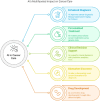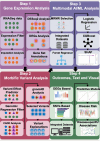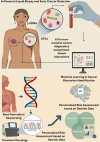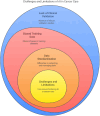Current AI technologies in cancer diagnostics and treatment
- PMID: 40457408
- PMCID: PMC12128506
- DOI: 10.1186/s12943-025-02369-9
Current AI technologies in cancer diagnostics and treatment
Abstract
Cancer continues to be a significant international health issue, which demands the invention of new methods for early detection, precise diagnoses, and personalized treatments. Artificial intelligence (AI) has rapidly become a groundbreaking component in the modern era of oncology, offering sophisticated tools across the range of cancer care. In this review, we performed a systematic survey of the current status of AI technologies used for cancer diagnoses and therapeutic approaches. We discuss AI-facilitated imaging diagnostics using a range of modalities such as computed tomography, magnetic resonance imaging, positron emission tomography, ultrasound, and digital pathology, highlighting the growing role of deep learning in detecting early-stage cancers. We also explore applications of AI in genomics and biomarker discovery, liquid biopsies, and non-invasive diagnoses. In therapeutic interventions, AI-based clinical decision support systems, individualized treatment planning, and AI-facilitated drug discovery are transforming precision cancer therapies. The review also evaluates the effects of AI on radiation therapy, robotic surgery, and patient management, including survival predictions, remote monitoring, and AI-facilitated clinical trials. Finally, we discuss important challenges such as data privacy, interpretability, and regulatory issues, and recommend future directions that involve the use of federated learning, synthetic biology, and quantum-boosted AI. This review highlights the groundbreaking potential of AI to revolutionize cancer care by making diagnostics, treatments, and patient management more precise, efficient, and personalized.
Keywords: Artificial intelligence (AI); Cancer; Cancer diagnosis; Deep learning (DL); Machine learning (ML); Precision oncology.
© 2025. The Author(s).
Conflict of interest statement
Declarations. Ethics approval and consent to participate: Not applicable. Competing interests: The authors declare no competing interests.
Figures








References
-
- Cancer. Available from: https://www.who.int/news-room/fact-sheets/detail/cancer. Cited 2025 Apr 5.
-
- Sung H, Ferlay J, Siegel RL, Laversanne M, Soerjomataram I, Jemal A, et al. Global Cancer Statistics 2020: GLOBOCAN Estimates of Incidence and Mortality Worldwide for 36 Cancers in 185 Countries. CA Cancer J Clin. 2021;71:209–49. - PubMed
-
- The global challenge of cancer. Nat Cancer. 2020;1:1–2. - PubMed
-
- LeCun Y, Bengio Y, Hinton G. Deep learning. Nature. 2015;521:436–44. - PubMed
Publication types
MeSH terms
Substances
Grants and funding
LinkOut - more resources
Full Text Sources
Medical

